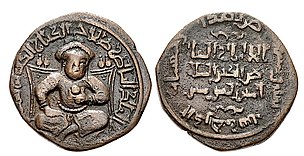 W
WSaif ad-Din Ghazi I was the Emir of Mosul from 1146 to 1149, who fought in the Second Crusade. He was the eldest son of Imad al-Din Zengi of Mosul, and the elder brother of Nur ad-Din.
 W
WAbu'l-Maymūn ʿAbd al-Majīd ibn Muḥammad ibn al-Mustanṣir, better known by his regnal name as al-Ḥāfiẓ li-Dīn Allāh, was the eleventh caliph of the Fatimids, ruling over Egypt from 1132 to his death in 1149, and the 21st imam of Hafizi Isma'ilism.
 W
WImad al-Din Zengi, also romanized as Zangi, Zengui, Zenki, and Zanki, was a Turkmen atabeg who ruled Mosul, Aleppo, Hama, and, later, Edessa. He was the namesake of the Zengid dynasty.
 W
WMesud I, Masud I or Mas‘ūd I (Modern Turkish: I. Rükneddin Mesud or Rukn al-Dīn Mas'ūd was the sultan of the Sultanate of Rûm from 1116 until his death in 1156.
 W
WAl-Muqtafi was the Abbasid caliph in Baghdad from 1136 to 1160, succeeding his nephew al-Rashid, who had been forced to abdicate by the Seljuks. The continued disunion and contests between Seljuk Turks afforded al-Muqtafi opportunity of not only maintaining his authority in Baghdad, but also extending it throughout Iraq.
 W
WNūr al-Dīn Maḥmūd Zengī, commonly known as Nur ad-Din, was a member of the Oghuz Turkish Zengid dynasty, which ruled the Syrian province (Shām) of the Seljuk Empire. He reigned from 1146 to 1174. He is regarded as an important figure of the Second Crusade.
 W
WAl-Nasir Salah al-Din Yusuf ibn Ayyub, better known simply as Salah ad-Din or Saladin, was a Sunni Muslim Kurd and the first sultan of Egypt and Syria and founder of the Ayyubid dynasty. Saladin led the Muslim military campaign against the Crusader states in the Levant. At the height of his power, his sultanate spanned Egypt, Syria, the Jazira, the Hejaz, Yemen, parts of western North Africa, and Nubia.
 W
WThe Zengid or Zangid dynasty was a Muslim dynasty of Oghuz Turkic origin, which ruled parts of the Levant and Upper Mesopotamia on behalf of the Seljuk Empire. The dynasty was founded by Imad ad-Din Zengi.